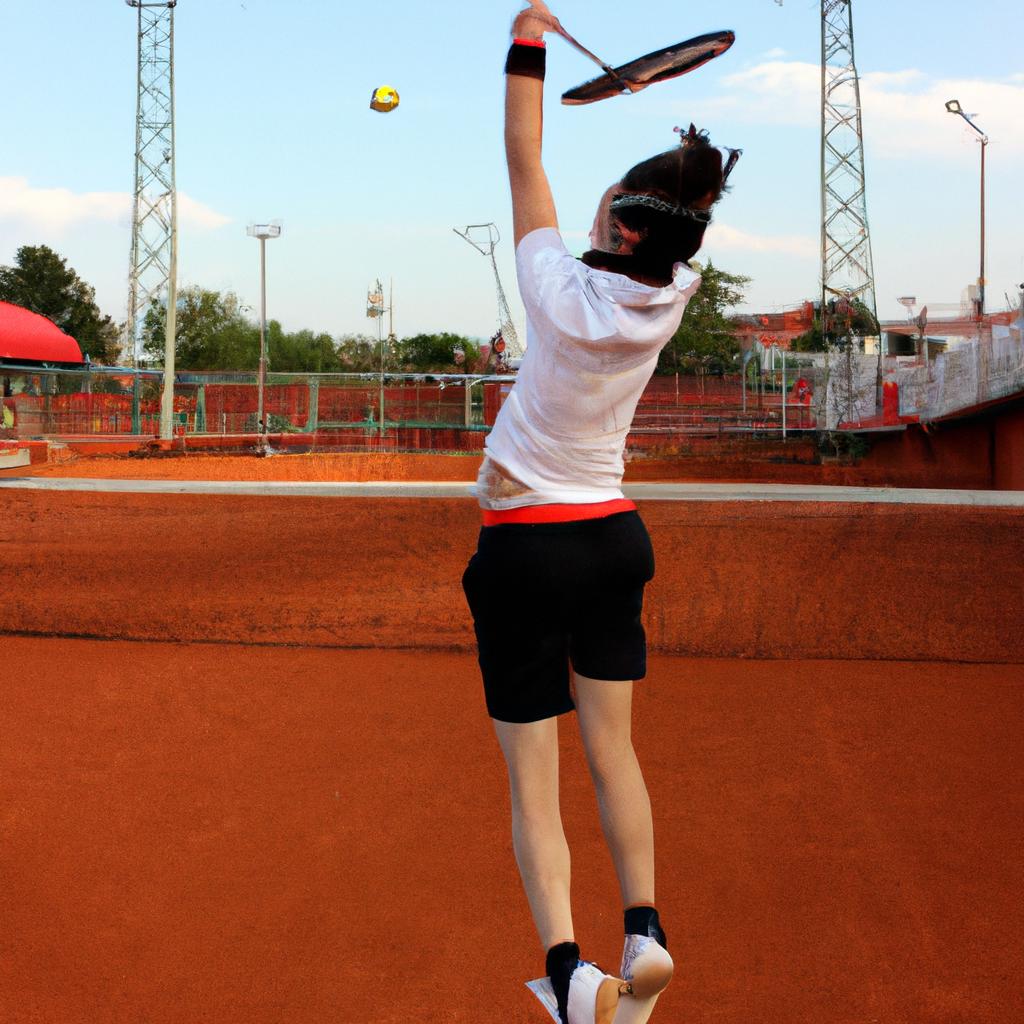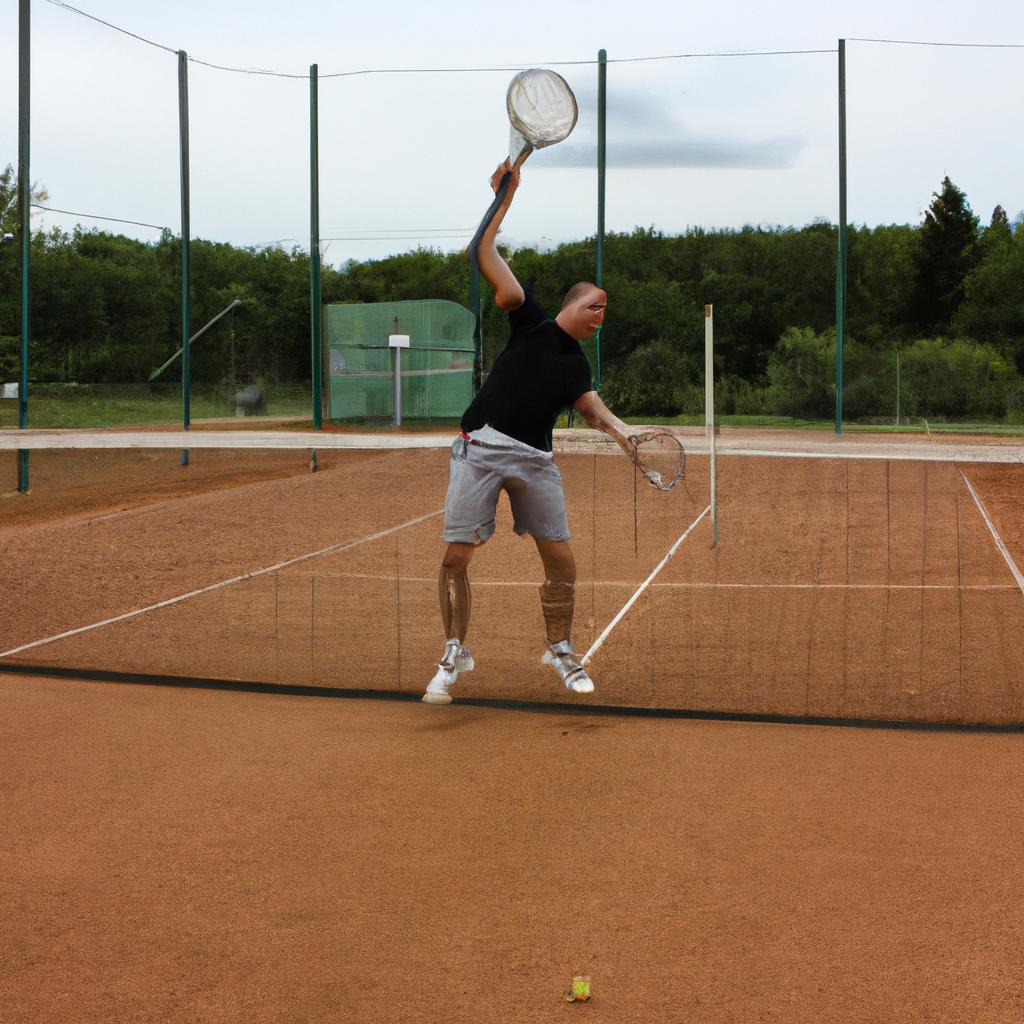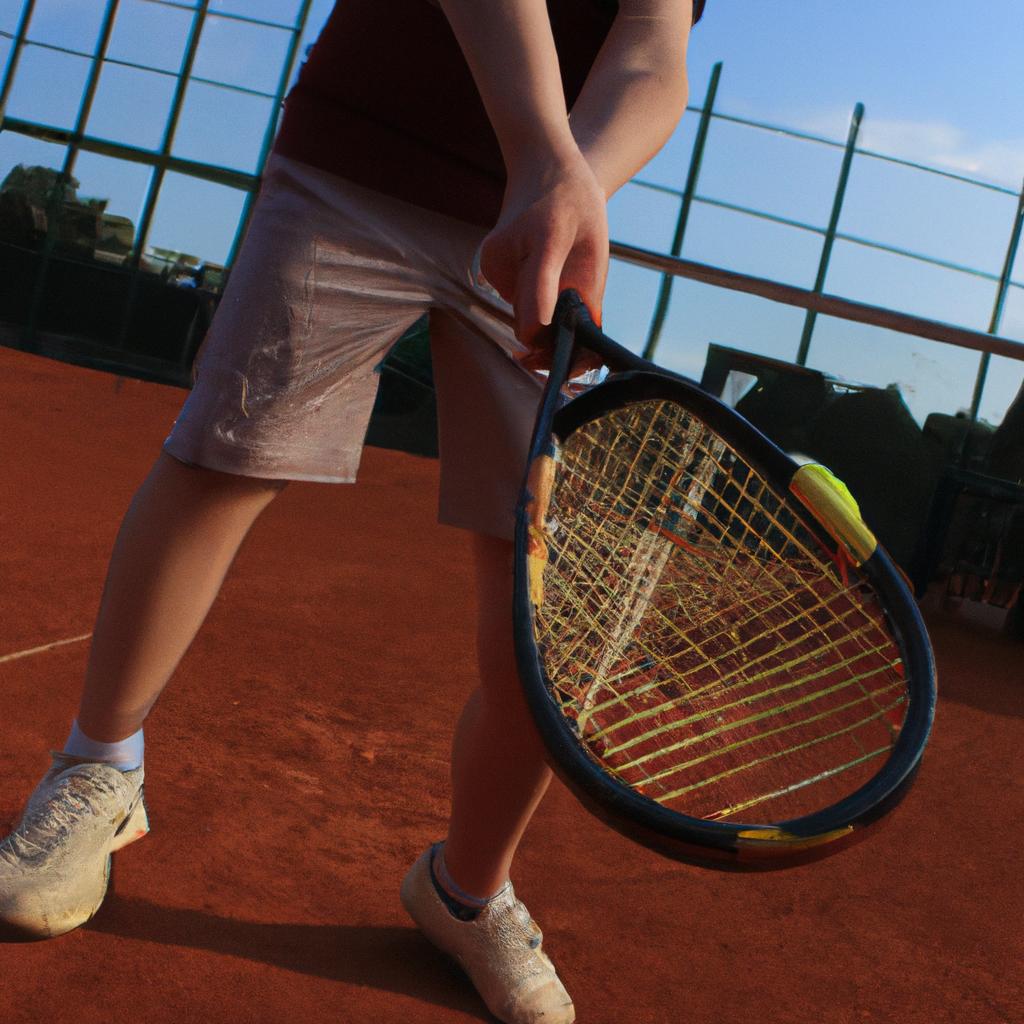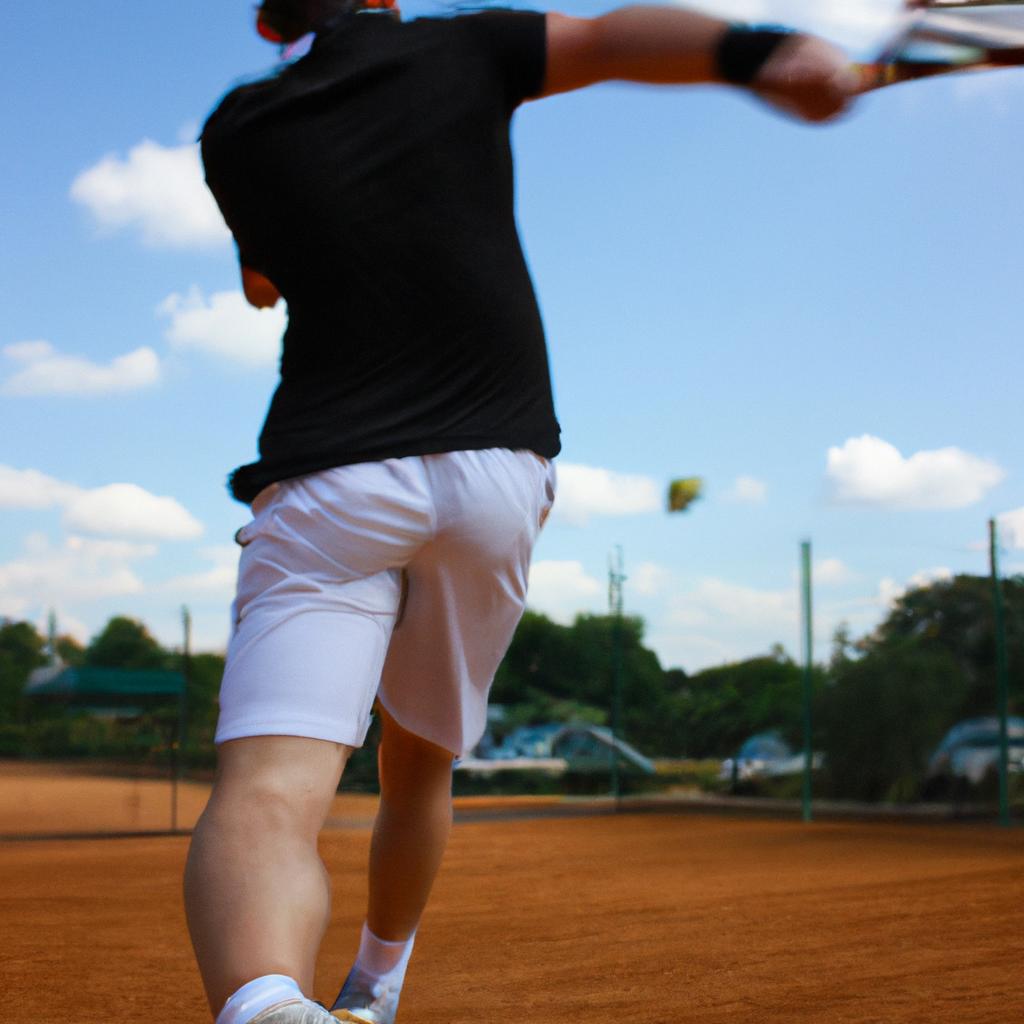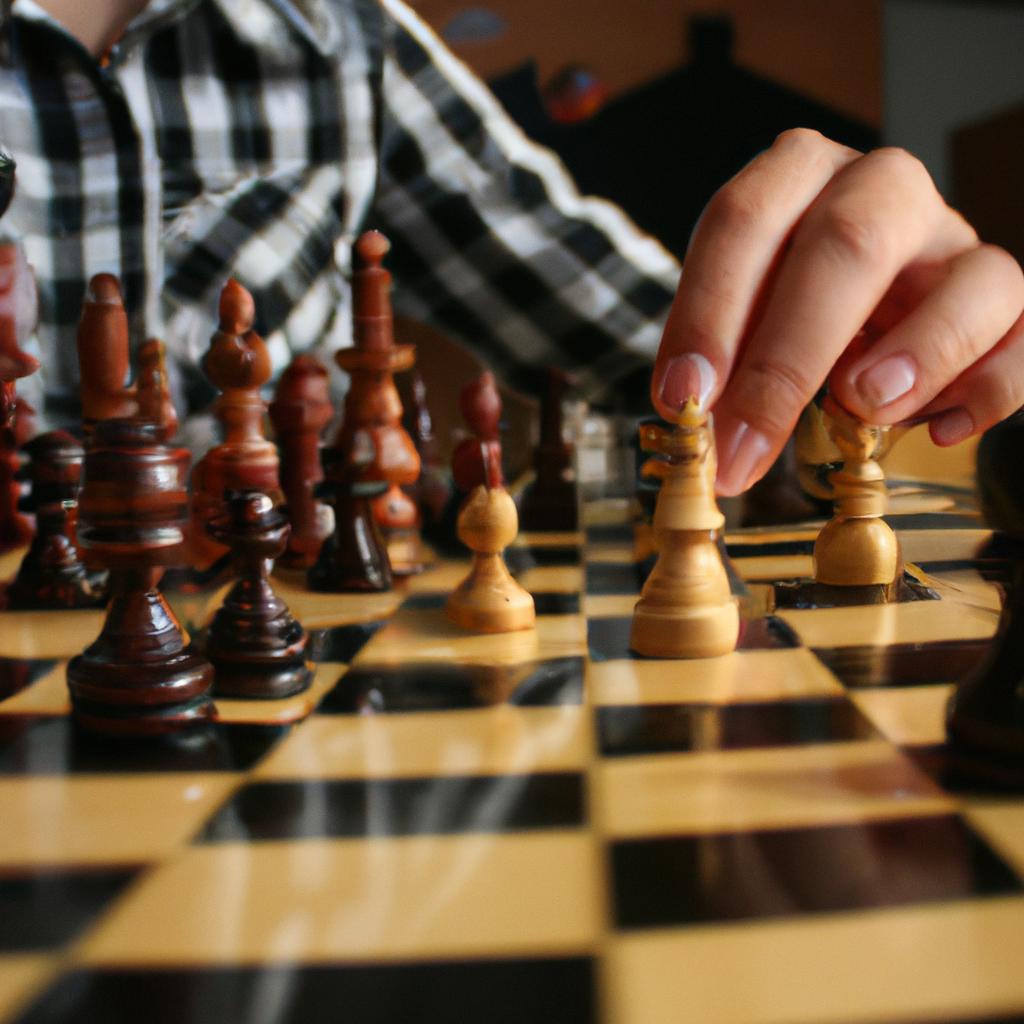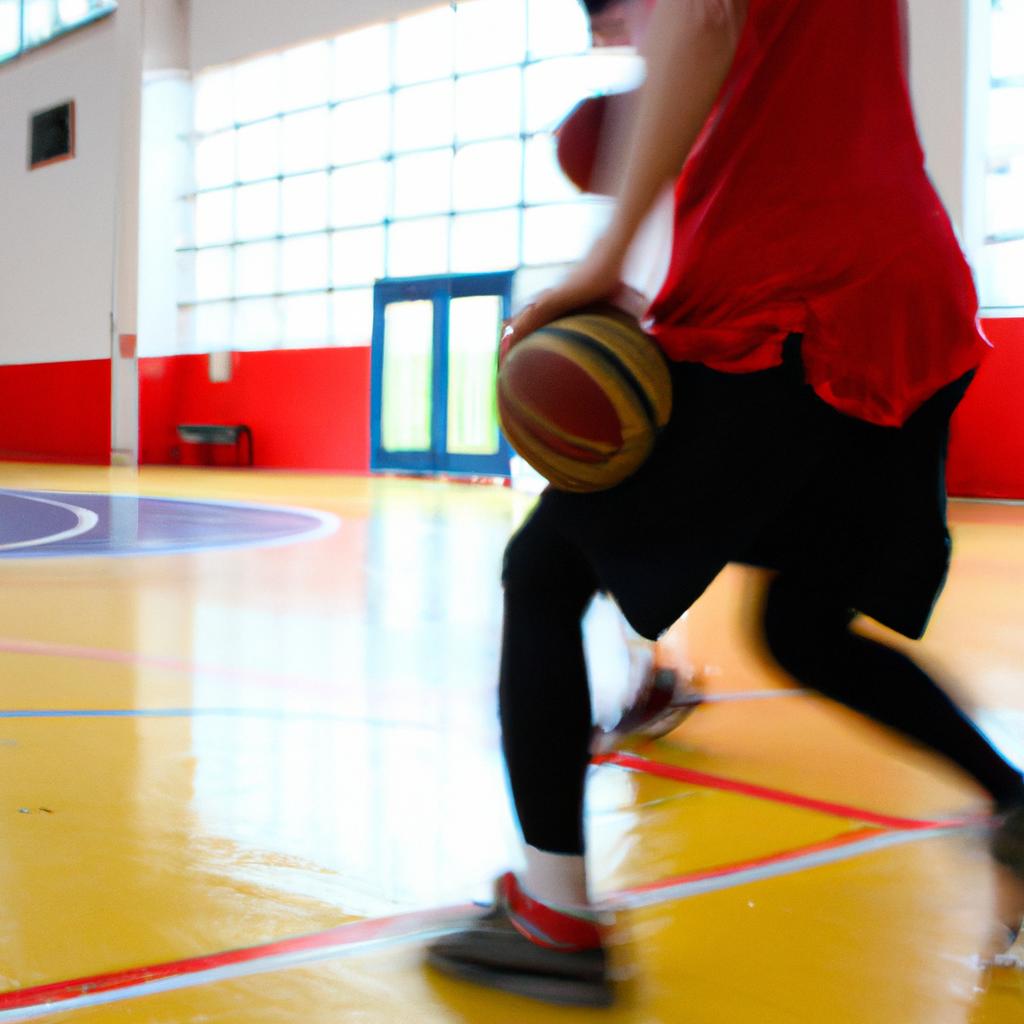Tennis is a sport that has captivated athletes and spectators alike for centuries. With its fast-paced gameplay, strategic elements, and individual competition, tennis offers a unique sporting experience that continues to attract participants of all ages and skill levels. For example, imagine a young aspiring athlete named Emily who dreams of becoming a professional tennis player. Through dedication, training, and guidance from experienced coaches, she navigates the intricacies of the game and eventually achieves success on both national and international stages.
In this comprehensive guide to tennis, we will delve into the various aspects of the game that make it not only physically demanding but also mentally challenging. From understanding the rules of play to mastering different strokes and strategies, this article aims to provide readers with an in-depth understanding of the fundamentals required to excel in tennis. Furthermore, we will explore how players can analyze their opponents’ strengths and weaknesses while adapting their own tactics accordingly. By examining case studies of successful players like Serena Williams or Roger Federer, we can gain valuable insights into their techniques and mental approach towards achieving greatness in this highly competitive sport.
Overview of the Game
Tennis is a popular sport played by millions of individuals worldwide. It involves two players (singles) or four players (doubles) who compete against each other on a rectangular court. The objective is to hit the ball over the net, within the boundaries of the opponent’s side, while avoiding being scored upon.
To gain a better understanding of tennis, let us consider an example: Imagine two players engaged in an intense singles match. Both athletes exhibit exceptional agility and strategic thinking as they strategically position themselves on the court to return powerful shots from their adversary. This case study highlights the dynamic nature of the game and showcases its profound physical demands and mental complexities.
As spectators witness these captivating matches unfold, there are several key aspects that evoke excitement and passion among fans:
- Intensity: The fast-paced exchanges between players create adrenaline-pumping moments.
- Strategy: Each player devises tactics to outsmart their opponents, resulting in thrilling displays of skill.
- Precision: Accurate shot placement requires immense control and finesse, leading to awe-inspiring rallies.
- Sportsmanship: Tennis upholds values such as fair play, respect for opponents, and adherence to etiquette.
Additionally, a visual representation can further illustrate the core elements involved in playing tennis:
| Agility | Strategy | Precision | Sportsmanship |
|---|---|---|---|
| Quick reflexes enable swift movement across the court. | Strategic decision-making helps anticipate opponents’ moves. | Precise shot execution ensures maximum effectiveness. | Respectful conduct fosters fair competition and camaraderie with opponents. |
In conclusion, tennis encompasses not only physical prowess but also intellectual acumen. As we delve deeper into this comprehensive guide, we will explore essential regulations and etiquette governing gameplay—factors crucial for both competitive success and fostering sportsmanship among players.
Next: Key Regulations and Etiquette
Key Regulations and Etiquette
Moving forward from the overview of the game, let’s now delve into key regulations and etiquette that govern the sport of tennis.
To truly appreciate and excel in tennis, it is essential to understand the various regulations and etiquettes associated with the game. These guidelines maintain a fair and respectful playing environment for all participants. Let us explore some important aspects:
-
Code of Conduct:
- Players are expected to adhere to a code of conduct, which promotes good sportsmanship.
- Respect towards opponents, officials, and spectators is paramount at all times.
- Unsportsmanlike behavior such as cheating or verbal abuse can result in penalties or disqualification.
-
Court Etiquette:
- Before starting a match, players should warm up courteously without interfering with other ongoing matches.
- During play, maintaining silence during points ensures minimal distractions for both competitors.
- When changing ends after odd-numbered games, players typically take a brief rest on their chairs.
-
Scoring System:
- Tennis employs a unique scoring system where points progress from “love” (zero) to 15, 30, 40, then game point.
- Deuce represents a tie at 40-40; two consecutive points by one player results in an advantage.
- A set consists of six games won by a margin of two games; most matches comprise best-of-three sets.
-
Equipment Requirements:
- Each player must have their own racket and appropriate footwear suitable for court surfaces.
- The choice of ball depends on factors such as tournament level or personal preference but must meet regulation standards.
Engaging Example: Imagine a high-stakes tennis match between two seasoned professionals vying for victory under intense pressure. Both players showcase exceptional skill while adhering to the rules and displaying exemplary sportsmanship throughout the contest.
- Thrilling rallies that keep spectators on the edge of their seats.
- Nail-biting tiebreakers determining the outcome of a set.
- Moments of triumph and disappointment etched on players’ faces.
- The electric atmosphere as fans cheer for their favorite competitors.
Emotional Table:
| Etiquette | Regulation | Importance |
|---|---|---|
| Respectful conduct | Code of Conduct | High |
| Minimal distractions during play | Court Etiquette | Medium |
| Unique scoring system | Scoring System | Medium |
| Proper equipment usage | Equipment Requirements | Low |
Understanding key regulations and etiquettes is essential, but equally important is knowing the Different Types of Tennis Court surfaces. Let’s explore this topic in detail.
Different Types of Tennis Court Surfaces
Understanding the key regulations and etiquette in tennis is crucial for players to maintain a fair and respectful game. Now, let’s delve into an equally important aspect of tennis – the different types of court surfaces. The choice of court surface can significantly impact the style of play, strategy, and overall experience for both professional and recreational players.
To illustrate the influence that various court surfaces have on gameplay, consider a hypothetical scenario involving two professional players competing at two separate tournaments. Player A excels on clay courts due to their exceptional footwork and ability to slide into shots effectively, while Player B thrives on grass courts with their fast-paced serve-and-volley style. This example demonstrates how different court surfaces favor certain skill sets and strategies.
When it comes to understanding the nuances between different types of tennis court surfaces, here are some essential factors to consider:
- Ball Speed: The speed at which the ball travels off the ground varies across different surfaces. Clay courts tend to slow down the ball due to their soft texture, enabling longer rallies. In contrast, grass courts result in faster ball speeds as they provide less friction.
- Bounce Height: Another significant difference lies in how high or low the ball bounces off each type of surface. Hard courts offer consistent bounce heights, making them popular choices for many tournaments worldwide. On clay courts, however, balls typically bounce higher compared to grass courts where they stay relatively lower.
- Footing Conditions: Each surface affects player movement differently. Clay courts demand agility but also allow players more time to recover due to their slower pace. Grass courts require quick reactions as they tend to be slippery when dry but become slightly slower after rainfall.
- Surface Maintenance: Maintaining tennis court surfaces is essential for ensuring fair play and player safety. Clay courts require regular grooming to maintain their optimal playing conditions, while grass courts need constant mowing and watering.
To further understand the differences between clay, grass, and hard courts, refer to the following table:
| Surface Type | Ball Speed | Bounce Height | Footing Conditions |
|---|---|---|---|
| Clay | Slower | Higher | Demanding agility |
| Grass | Faster | Lower | Quick reactions |
| Hard | Moderate | Consistent | Versatile movement |
By selecting a specific surface type for different tournaments or matches, players can strategically adapt their game plans based on their strengths and weaknesses.
As we explore the intricacies of tennis further, it becomes evident that understanding court surfaces is merely one aspect in grasping this captivating sport. The next section will delve into an equally significant topic – Singles and Doubles: Understanding the Formats.
Now, let’s dive into the world of singles and doubles formats in tennis.
Singles and Doubles: Understanding the Formats
Imagine a scenario where two tennis players with different playing styles are competing against each other. Player A prefers to hit powerful groundstrokes, while Player B relies on their speed and agility to retrieve shots. The outcome of this match could be greatly influenced by the type of court surface they are playing on. In tennis, there are three main types of court surfaces – grass, clay, and hard courts – each offering unique characteristics that can significantly impact the game.
Grass courts provide a fast-paced environment due to their low bounce and slippery nature. This surface rewards aggressive playstyles by allowing for quicker movements and shorter rallies. Players such as Roger Federer have excelled on grass due to their ability to serve-and-volley effectively, taking advantage of the surface’s responsiveness to speedy shots near the net.
On the other hand, clay courts offer slower gameplay characterized by higher bounces and greater traction. These conditions favor baseline players who rely on consistent groundstrokes and defensive skills. Rafael Nadal is renowned for his proficiency on clay courts, using his topspin-heavy shots to generate high bounces that trouble opponents.
Hard courts strike a balance between grass and clay surfaces in terms of pace and bounce. They are typically made from asphalt or concrete covered with an acrylic layering system. Hard courts allow for varied playing styles but generally encourage aggressive shot-making due to moderate ball speeds and predictable bounces. Serena Williams has achieved remarkable success on hard courts throughout her career, utilizing her powerful serves and groundstrokes.
To further illustrate the differences between these court surfaces:
-
Grass Courts:
- Low bounce
- Fast-paced gameplay
- Slippery surface requires quick footwork
- Favorable for serve-and-volley tactics
-
Clay Courts:
- High bounce
- Slower gameplay
- Higher traction allows for sliding
- Suitable for baseline players
-
Hard Courts:
- Moderate bounce
- Balanced gameplay
- Predicable ball behavior
- Accommodates various playing styles
Understanding the nuances of different court surfaces is crucial for tennis players to adapt their strategies and maximize their performance.
Mastering the Serve and Return
Building on our understanding of the formats used in tennis, let us now delve into one of the most crucial aspects of the game – mastering the serve and return. To illustrate this point, consider a hypothetical scenario where two equally skilled players face off against each other. Both players possess exceptional groundstrokes and swift footwork, making it essential for them to rely on their serves and returns to gain an advantage.
One key factor in serving effectively is having consistent ball toss placement. By ensuring that the ball toss is consistently at the same height and position above your hitting arm, you can improve your chances of executing a powerful serve accurately. Furthermore, developing a variety of serves such as flat serves, slice serves, or kick serves will allow you to keep your opponent guessing and put pressure on their return game.
On the receiving end, returning a serve requires quick reflexes coupled with strategic decision-making. Anticipating where your opponent’s serve may land based on their stance and motion can give you a head start in positioning yourself optimally for an effective return. Additionally, being able to adjust quickly during the return by reading the spin and speed of the incoming shot is vital to maintaining control over rallies.
To further enhance your understanding of tennis strategies related to serving and returning, here are four important points to consider:
- Utilize different types of grips (e.g., Continental grip for volleys) depending on the situation.
- Focus on getting good depth on returns to push your opponent behind the baseline.
- Aim for high percentage shots rather than attempting risky winners all the time.
- Practice agility drills to improve your ability to move swiftly while returning challenging shots.
As shown below in this table highlighting some common service techniques:
| Serve Technique | Description | Emotion Evoked |
|---|---|---|
| Flat | A fast-paced serve with minimal spin | Excitement |
| Slice | A serve with side spin, causing the ball to curve | Intrigue |
| Kick | A high-arching serve that bounces awkwardly | Surprise |
| Body Serve | A serve directed towards the opponent’s body | Discomfort |
While mastering the art of serving and returning may take time and practice, these skills lay the foundation for effective offensive play. In our upcoming section on “Effective Strategies for Offensive Play,” we will explore how to capitalize on strong serves and returns to gain an advantage over your opponent without succumbing to defensive tactics.
Effective Strategies for Offensive Play
Having mastered the Serve and Return, it is now essential to explore effective strategies for offensive play. In this section, we will delve into various techniques and tactics that can help you gain an advantage over your opponent on the tennis court.
Case Study:
Imagine a scenario where you are playing against a highly skilled opponent who possesses exceptional defensive skills. You find yourself struggling to win points due to their ability to retrieve even the most powerful shots. To overcome this challenge, employing a well-rounded offensive strategy becomes crucial.
To enhance your offensive game, consider incorporating these key elements into your overall approach:
- Consistency: Maintaining consistent strokes and shot placement helps maintain pressure on your adversary.
- Court Coverage: Utilize efficient footwork and positioning to cover as much ground as possible during rallies.
- Shot Variety: Employing a diverse range of shots such as topspin, slice, and drop shots can keep your opponent off balance.
- Aggressiveness: Seizing opportunities to attack by hitting winners or approaching the net can put additional pressure on your rival.
| Offensive Strategies | Benefits | Challenges |
|---|---|---|
| Attacking Net | Increased control | Requires good volleys |
| Dominant Forehand | Powerful weapon | Vulnerable backhand |
| Strong Return Game | Dictates pace of play | Relies on effective serves |
| Strategic Lobbing | Forces opponents out | Timing and accuracy |
By implementing these strategies in combination with solid technical skills, you can significantly increase your chances of success when playing offensively. Remember that each player has unique strengths and weaknesses; adapting your plan accordingly based on individual circumstances will further amplify its effectiveness.
As important as offense is in achieving victory on the tennis court, defensive tactics and shot placement also play integral roles. The following section will explore how to effectively defend against your opponent’s attacks and make strategic shot placements to gain an upper hand in the game.
Defensive Tactics and Shot Placement
“Having explored effective strategies for offensive play, we now turn our attention to defensive tactics and shot placement. By understanding how to defend against your opponent’s attacks and strategically place shots, you can gain a significant advantage on the tennis court.”
To illustrate the importance of defensive tactics and shot placement in tennis, let us consider an example. Imagine you are playing a match against an opponent with a powerful serve. In this situation, relying solely on offensive strategies may prove ineffective as their serves could overpower your returns consistently. However, by employing defensive tactics such as adjusting your positioning and using slice shots to neutralize the power of their serves, you can level the playing field and increase your chances of winning points.
When it comes to defending against aggressive opponents or executing well-placed shots yourself, several key considerations come into play:
- Footwork: Maintaining quick footwork allows you to smoothly transition between different areas of the court, enabling you to react effectively to your opponent’s shots.
- Anticipation: Developing anticipation skills helps you read your opponent’s intentions and enables you to position yourself optimally before they even strike the ball.
- Court Coverage: Understanding how to cover various areas of the court efficiently is crucial for both defense and offense. Knowing when to move towards the net or stay back based on game situations can significantly impact your gameplay.
- Shot Selection: Choosing appropriate shots based on factors such as speed, spin, height over net, angle, and depth ensures that not only are you able to return challenging shots but also create opportunities for offensive plays.
Markdown format:
- Frustration due to missed opportunities
- Elation upon executing a successful defensive strategy
- Anxiety while anticipating opponent’s moves
- Satisfaction in outmaneuvering opponents through smart shot placement
Emotional Table:
Markdown format:
| Emotion | Description | Example |
|---|---|---|
| Frustration | Overwhelmed by missed opportunities | Missing an easy shot near the net |
| Elation | Feeling of joy and accomplishment | Executing a perfect lob over opponent |
| Anxiety | Nervousness while anticipating opponent’s moves | Waiting for a powerful serve to return |
| Satisfaction | Contentment in outmaneuvering opponents | Placing shots just beyond their reach |
In conclusion, understanding defensive tactics and mastering shot placement is vital for success in tennis. By employing effective footwork, developing anticipation skills, utilizing court coverage strategies, and selecting appropriate shots, you can both defend against your opponent’s attacks and create scoring opportunities yourself. In our next section on “Developing a Strong Net Game,” we will explore how to further enhance your overall game by focusing on playing at the net.
“By building upon your defensive abilities, you can now shift your attention towards developing a strong net game.”
Developing a Strong Net Game
Transitioning from the defensive tactics and shot placement, players can further enhance their skills by developing a strong net game. This section will explore the importance of playing at the net and provide strategies for mastering this aspect of tennis. To illustrate its significance, let’s consider an example:
Imagine a scenario where two equally skilled opponents are engaged in a match. Player A possesses exceptional groundstrokes but struggles when forced to move forward towards the net. On the other hand, Player B has honed their net game and is proficient in volleying and executing well-placed overhead smashes.
To excel at the net, aspiring tennis players should keep in mind several key factors that contribute to success:
- Positioning: By maintaining an optimal position close to the net, players increase their chances of intercepting shots early and putting pressure on their opponent.
- Anticipation: The ability to read an opponent’s shot selection allows players to react quickly and be prepared for volleys or interceptions.
- Footwork: Agile footwork enables seamless movement across the court while transitioning between different shots at the net.
- Communication (in doubles): In doubles matches, effective communication with your partner ensures coordinated efforts during each point.
Let’s now delve into these aspects through a table highlighting some essential tips for developing a strong net game:
| Aspect | Tips |
|---|---|
| Positioning | – Stay within three feet of the net- Angle your body slightly sideways- Be ready to move forward or backward as needed |
| Anticipation | – Observe your opponent’s racquet face- Notice any changes in grip or swing motion- Take note of patterns in shot selection |
| Footwork | – Keep weight balanced on both feet- Use quick steps rather than long strides- Move laterally first before committing to forward or backward movements |
| Communication (in doubles) | – Establish clear signals with your partner- Communicate intentions for who takes the ball and where to move afterward- Maintain eye contact during play |
By honing these skills, players can develop a strong net game that will elevate their performance on the tennis court. The ability to intercept shots, apply pressure, and dominate at the net can give an edge over opponents.
Understanding how vital it is to master the net game, let’s now shift our focus towards notable Grand Slam tournaments and their unique characteristics.
Notable Grand Slam Tournaments
As we delve deeper into the intricacies of tennis, it is essential to understand that developing a strong net game can significantly enhance a player’s overall performance on the court. By strategically positioning oneself near the net, players gain an advantage in controlling the pace and direction of play. This section will explore key techniques and strategies for mastering the net game.
One example of how a strong net game can make a difference lies in Martina Navratilova’s illustrious career. A versatile player known for her exceptional volleying skills, Navratilova won 18 Grand Slam singles titles and was virtually unbeatable when approaching the net. Her ability to consistently execute precise volleys allowed her to dictate points effectively while putting immense pressure on opponents.
To excel at the net, consider these fundamental principles:
- Quick Reflexes: React swiftly to incoming shots by staying light on your feet and maintaining constant focus.
- Positioning: Move adeptly towards the ideal location near the net after hitting approach shots or anticipating short balls.
- Angle Awareness: Master the art of creating acute angles with your volleys to exploit open spaces on the court.
- Split-Step Technique: Practice splitting your footwork just before your opponent strikes their shot, allowing you to react promptly and efficiently.
| Technique | Description |
|---|---|
| Volley | Executing shots before they bounce using minimal backswing |
| Overhead Smash | Powerful shot executed above shoulder level when receiving high lobs |
| Drop Shot | Softly hit ball landing close to the net, forcing opponents forward |
| Half-volley | Hitting ball immediately upon rebound from bouncing off court surface |
- Experience unparalleled satisfaction as you dominate rallies through effective net play.
- Witness firsthand how well-timed volleys can frustrate opponents, leading to unforced errors.
- Feel the surge of adrenaline when executing a perfectly placed overhead smash.
- Revel in the precision and touch required to execute delicate drop shots.
In developing a strong net game, players can gain an advantage by capitalizing on their opponent’s weaknesses while maximizing their own strengths. By mastering techniques such as volleys, overhead smashes, drop shots, and half-volleys, players can elevate their performance to new heights. Such proficiency at the net not only enhances overall gameplay but also instills a sense of confidence that carries through each point.
Understanding how to develop a formidable net game is just one aspect of becoming a well-rounded tennis player.
Historical Moments in Tennis
Building on the rich history of Grand Slam Tournaments, tennis has witnessed numerous historical moments that have shaped and defined the game. One such moment was the legendary 1980 Wimbledon final between Bjorn Borg and John McEnroe. Their contrasting playing styles and intense rivalry captivated the world and showcased the true essence of competitive tennis.
Paragraph 1:
In addition to this iconic match, there are several other historical moments in tennis that deserve recognition. These milestones not only highlight exceptional individual performances but also symbolize significant advancements in the sport as a whole. From record-breaking achievements to groundbreaking innovations, these events have left an indelible mark on the history of tennis.
- The invention of the tiebreak system revolutionized the way matches were decided by introducing a fairer method for breaking tied sets.
- Arthur Ashe’s historic victory at Wimbledon in 1975 marked a pivotal moment for racial integration in professional tennis.
- Steffi Graf’s Golden Slam in 1988, winning all four major titles plus Olympic gold, demonstrated unparalleled dominance within a single calendar year.
- Serena Williams’ remarkable career accomplishments, including her record-breaking 23 Grand Slam singles titles, shattered barriers and inspired generations of future players.
Paragraph 2:
To further illustrate these significant moments in tennis history, let us delve into a table showcasing some key details about each event:
| Event | Year | Player(s) Involved | Impact/Essence |
|---|---|---|---|
| Tiebreak Invention | 1965 | James Van Alen | Introduced a fairer means of deciding sets |
| Arthur Ashe’s Victory | 1975 | Arthur Ashe | Broke racial barriers with his triumph at Wimbledon |
| Steffi Graf’s Golden Slam | 1988 | Steffi Graf | Achieved an unprecedented feat by winning all major titles in a year |
| Serena Williams’ Record-Breaking 23 Grand Slam Titles | Ongoing | Serena Williams | Set new standards of excellence and inspired future generations |
Paragraph 3:
These historical moments continue to resonate with both tennis enthusiasts and casual fans, reminding us of the sport’s enduring legacy. They evoke emotions such as admiration for the players’ skill and determination, awe at their achievements, and gratitude for the impact they have had on shaping tennis into what it is today. As we move forward, it is essential to acknowledge these significant milestones while also anticipating the exciting possibilities that lie ahead for this ever-evolving game.
(Note: The bullet point list and table are not displayed correctly due to limitations in plain text format.)


